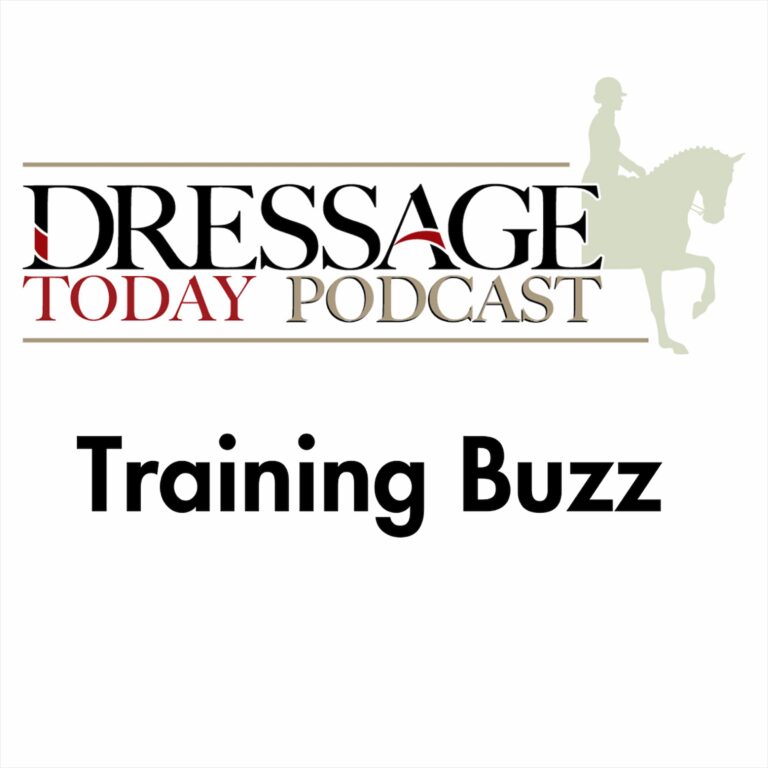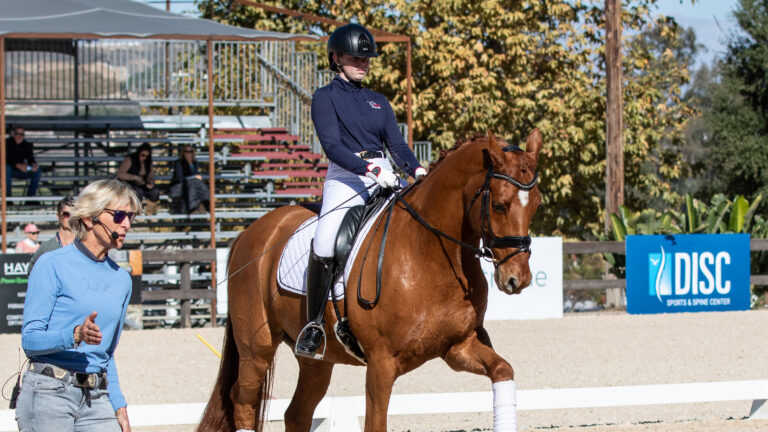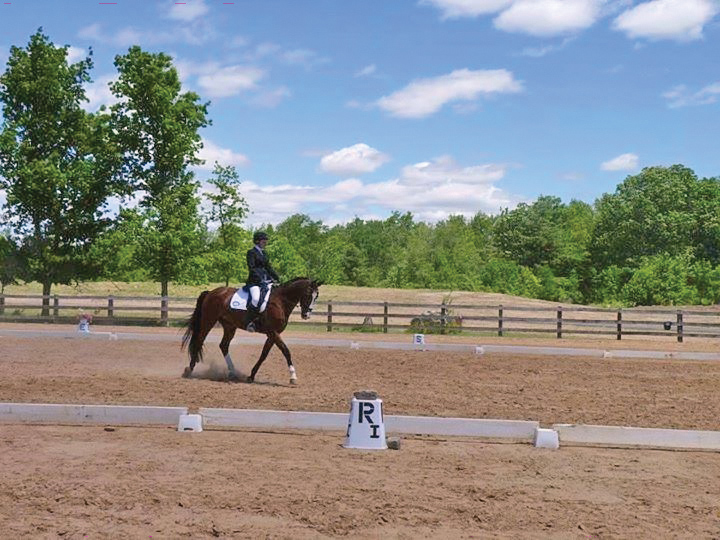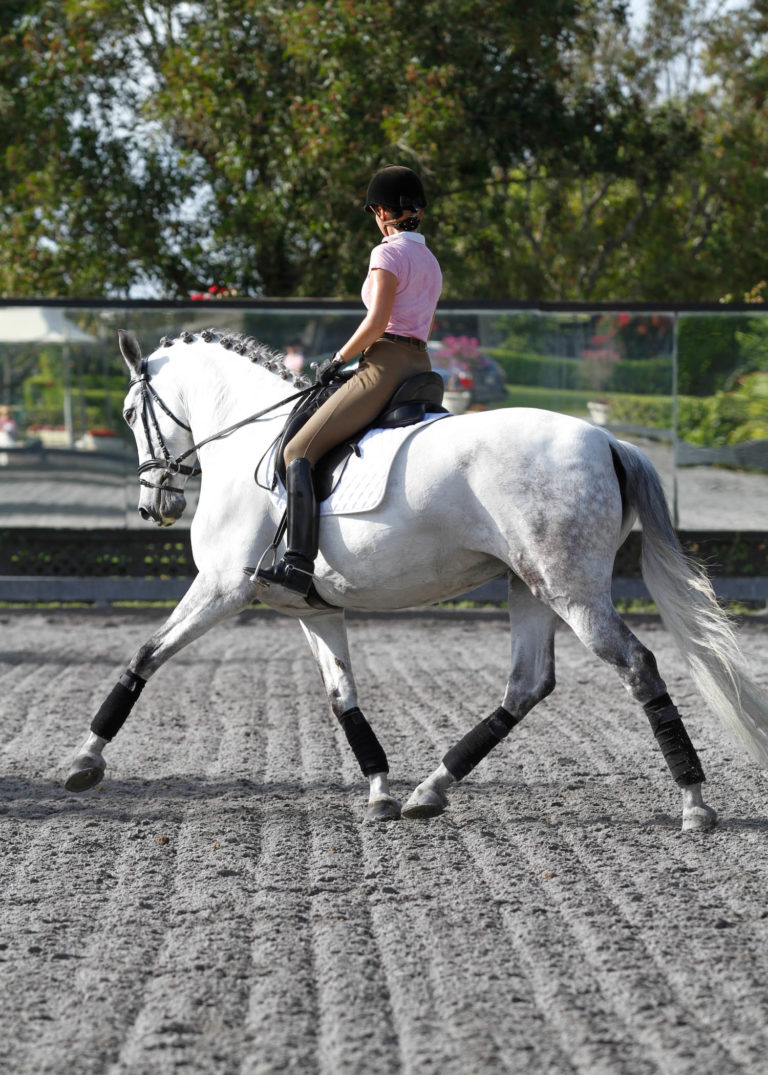I was ready. I had spent a month in intense preparation since receiving the exciting news that I had been selected as a demo rider for the U.S. Dressage Federation’s Region 9 Adult Clinic with master clinician Lilo Fore. With my 8-year-old Contango mare, Zandra ISF (“Zee”), I smiled, surrendered to Fore’s instruction and, two days later, had made an amazing and everlasting change to the way I ride.

The clinic riders quickly discovered that Fore is quiet only while watching the warm-up, assessing the main issue and deciding her plan of attack. After that, her instruction is constant and relentless. She corrects, clarifies and tweaks.
“Hands in front. Sit vertical. Straighten your horse. More elastic connection. Come on: one, two, one, two. No, no, you didn’t prepare. Supple him. That wasn’t a corner! Outside rein down. More bend. More forward. Shorten your reins. Keep the connection. No pulling. Flexion, not bending the neck. Be consistent. More activity. Follow with your seat. Look where you are going.”
And that, my friends, was only the first two minutes. “You must have a 10-track mind. If you only focus on one thing, you forget too many others,” Fore told us.
If you are asking yourself how you can possibly pay attention to your position, aids and connection, along with your horse’s gaits, frame, suppleness, responsiveness and energy, don’t panic. Using the familiar building blocks of the Training Scale as the 10 tracks, the many multidimensional, interconnected principles become more manageable.
Four Tracks for the Rider
1. Attitude—The rider’s goal should be improvement, not perfection. A great attitude is essential for good riding. It includes a willingness to not take it all too seriously (like knowing that if you don’t sit the trot today, the world will not come to an end) and being content with work that might not be good but is good enough for now. It means avoiding frustration, and rather than being afraid of mistakes, welcoming the lessons they teach. It takes the focus off winning and puts it onto enjoying every ride.
2. Position—The horse can only be as correct as the rider. Fore was adamant about the importance of position, for every detail that is amiss on this track can adversely affect the elements of every other track. She suggests having a mind’s-eye picture of an ideal rider so you can immediately notice what is amiss in your hands, seat, legs and balance.
3. Aids—Only precise riding will train the horse well. In addition to the correctness of the leg, seat, hands, weight, spur, whip aids, and combination of aids, this track also addresses their coordination, clarity, precision, timing and the feel that must accompany the technical skill. Fore also stressed the absolute necessity for proper preparation so the horse has the best chance of correctly responding to an aid.
4. Thinking/Feeling Rider—From the moment you get on, you are training the horse. This track is all about the relationship between the rider and the horse. It is keeping in mind why you do movements, not just how, knowing what exercises to use for which problems, when to push and when to back off. Most importantly, it is making sure what you are asking of the horse is fair and understandable.
Six Tracks for the Horse
5. Rhythm—The quality of the gait is essential. Rhythm monitors the correct footfalls. There must also be good energy and consistent tempo.
6. Relaxation—A horse that chews the reins out of the hands correctly is relaxed. To ensure the horse is relaxed in his muscles and mind, you observe his lateral bending, suppleness and elasticity as well as the smoothness of his transitions and the lengthening/shortening of his frame.
7. Connection—Hold your reins like you are holding something precious. Here, you would note if the contact is light, elastic and adjustable. Can you hear the quiet chewing of the bit? Seeing a tight neck means a tight back and, thus, a blocked “bridge” for the energy between the hindquarters and the hands.
8. Impulsion—Send your horse forward as if you’ve put his energy in a slingshot. Here you feel the horse taking you somewhere with the motorboat surge of his thrusting hindquarters, the lift of his suspension (except in the walk) and the swing of his supple back.
9. Straightness—The horse’s neck must be straight in front, just like the hood of a car. Whether his path is straight or curved, a straight horse aligns himself like a train on a track with you a comfortably balanced passenger. A horse that is crooked feels asymmetrical, especially in the reins, throwing you to one side. His energy feels stuck like water in a pinched hose.
10. Collection—Collected strides are smaller, not slower. The picture associated with the fulfillment of this track is the horse as an amazing athlete, displaying uphill self-carriage with easily adjustable, energetic steps and a cadenced bounce from his articulated hindquarters, resulting in the ease of riding with just your seat.
Refining the 10-Track Mind
Blessedly, the essential ingredient of this plan is to get out of your mind and notice only what you feel and detect what stands out as incorrect or insufficient, correct it quickly and move on to what you notice next. Once you have learned what to watch for at your level of riding, the remaining part of this program entails improving the quality and consistency of your attention and learning how to make the necessary corrections or improvements in a timely and effective manner.
Details. It is said that details make the difference between mediocre and magnificent. But as you begin trying out your 10-track mind, you’ll probably notice that many problems pop out at you all at once. Fore says, “Let your horse be your teacher, pay attention to his invaluable feedback.” Just address whatever is most glaring.
Discipline. “Discipline takes the 10-track philosophy from helpful to powerful,” Fore told us. It adds diligence, consistency, quickness, obedience and preparation to your work. Here are some of my favorite bits of wisdom from Lilo Fore that will help: “Stay focused, be tidy, slow things, ride every step. There are no tricks. Only precise riding trains the horse correctly. Be exact in your geometry, figures, lines. Make the first stride of your transition as good as the 10th stride. Fix the problem, then be done with it. Prepare, prepare, prepare! You must catch the mistake in the moment it is happening. Corrections must fit the crime. Don’t nag! Get a reaction, then leave it alone. Train obedience. The horse must be responsive for the aids to become invisible. Reward your horse, praise him; you want a willing, proud partner, not a slave. Be determined and one day you will build something worthy of your potential. First and foremost, you must be determined to be correct in your position, your aids, your improvements. This means not cheating, giving a quick fix with your whip or rein instead of really addressing the problem. Be willing to do it again and again until that proverbial light bulb shines.”
From my own experience in the clinic and since then, the good news is that when you are correct in your position and clear in your aids, many issues resolve themselves. Determination also requires patience and increasing the difficulty of your work when it makes sense, not because a new year means time for a new level. As Fore says, “There is no point working on flying changes until you have the right canter, or practicing the canter–walk transition until the canter–trot is good.” Most importantly, it means being committed to the ultimate development of your horse, understanding that movements aren’t an end in and of themselves, but dynamic tools to enhance your training.
Commit to Quality
During the clinic, Fore’s focus on the quality of the connection, the preparation, the rider’s position, the horse’s responsiveness, etc., made for a decisive difference that the audience could clearly see and understand. “The quality of the rider determines the quality of the horse,” she said. My first day she made adjustments to every one of my 10 tracks. Zee’s abrupt stops at the canter caught me so off guard that I lost my balance, position and connection. Fore called my effort to move Zee forward “ping-pong ball” kicks because my legs bounced right off her sides. She taught me to “sting like a bee” by turning my toes out and giving Zee two quick jabs with my spurs.
Fore’s work with Zee on the ground made me realize I had been too lax in her obedience work. When I was struggling to sit the trot, Fore had me keep my core strong but soften my elbows and hips so I could follow Zee’s strides more effectively. When the connection got so heavy that I was rounding my whole arm, she asked me to be more subtle in my suppling. “Flex a little left, a little right, soften with squeezes. Round her with just your ring finger,” Fore told me. Zee’s walk was too short and fast, so Fore strode alongside us, making me match our strides with her long, slow, swinging steps.
Fore’s philosophy has become a vital staple of my riding program and positively influenced my students’ training as well. I will be forever grateful for the opportunity to train with this master horsewoman, and will never forget how it felt to ride with the confidence, kindness and quality she asked for. Nor will I forget the smile she gave me when I finished and she said, “Brilliant!”









